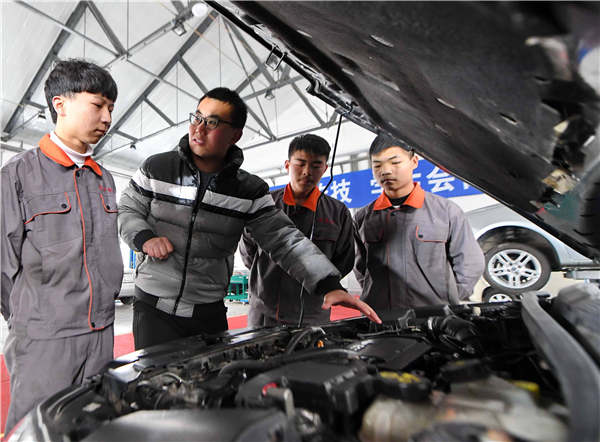Tailored training fills talent gap
 |
|
Students from a vocational school in Hebei province at an on-the-spot class at an automobile training base. [Photo/Xinhua] |
Guo Ying and Zhao Wanwei report on innovative vocational education.
After an 18-hour contest against 30 competitors from around the world, 21-year-old Hu Ping won the gold medal in fashion technology at the 44th WorldSkills Competition in Abu Dhabi, United Arab Emirates. She cut her cloth well within the stipulated time and perfectly matched a pattern.
Hu has been interested in handicrafts, especially making clothes, since she was a child. After graduating from junior middle school four years ago, she enrolled at the Beijing Industry and Trade Technician College to study costume design and production. She learned how to select fabrics for apparel, and techniques such as 3-D cropping, patternmaking and sewing production, paving the way for her success.
Hu's design teacher, Yang Yu, worked in the apparel industry for 15 years. With a deep understanding of the needs of the business and the technical challenges involved, she teaches practical skills.
"I hope to teach students what the market and industry really need. We hope to cultivate garment technologists who know both design and production. They can partner with the designers and put the design concept into detail-oriented clothes," Yang says.
The approach signals a new era in China's vocational education. According to a report delivered to the 19th National Congress of the Communist Party of China in October, the Party will "improve the system of vocational education and training, and promote integration between industry and education and cooperation between enterprises and colleges".
China has the world's largest vocational education system, with 12,300 colleges offering about 100,000 majors. Together these institutions have almost 27 million students, who will become the backbone of the modern manufacturing, strategic emerging and modern service industries.
Hu learned as much through work placements at apparel companies as she did in class. After discussions with designers, she went through the whole process of choosing fabrics, pattern-making and placing orders with the production department, and came up with her own products.
















